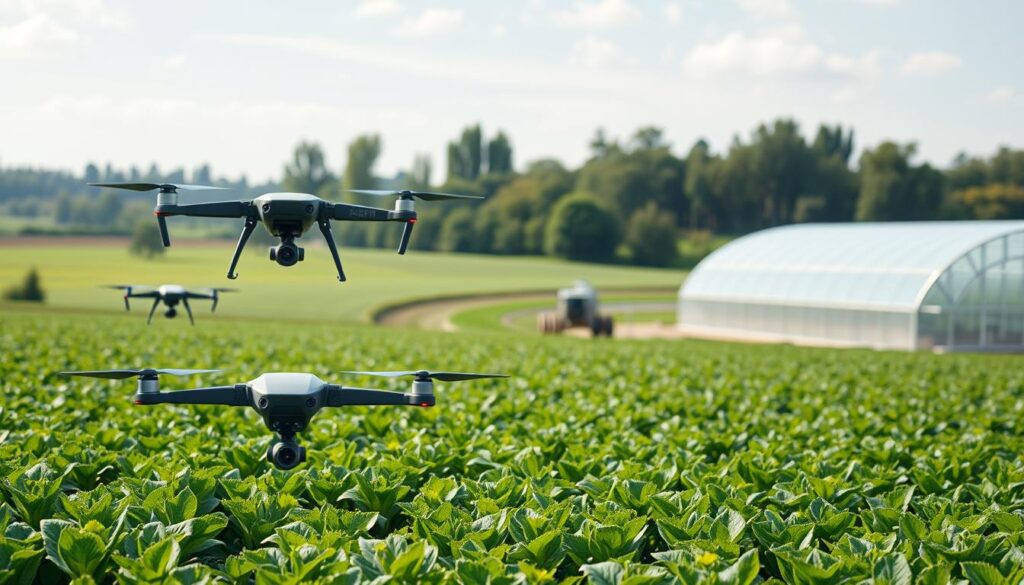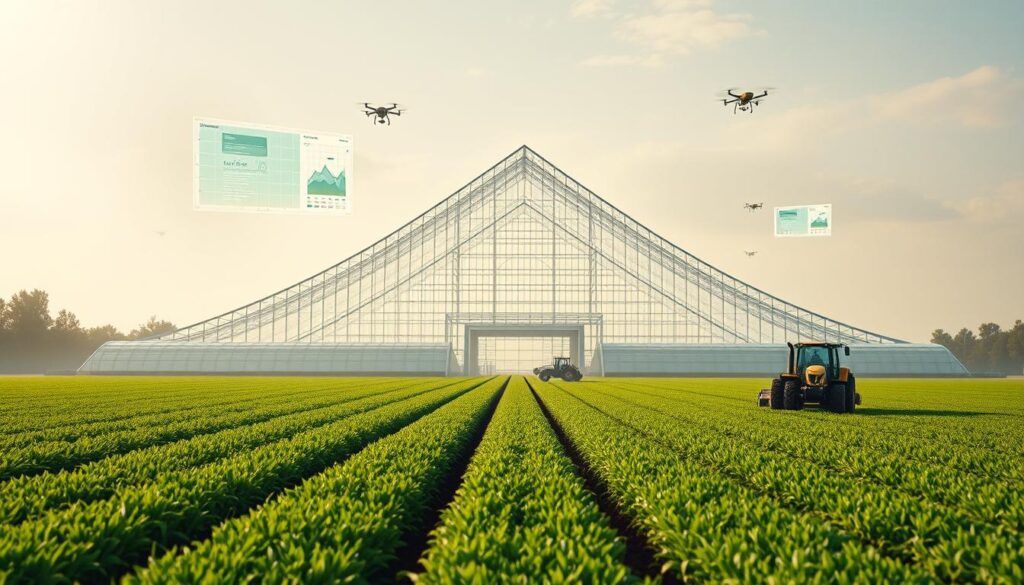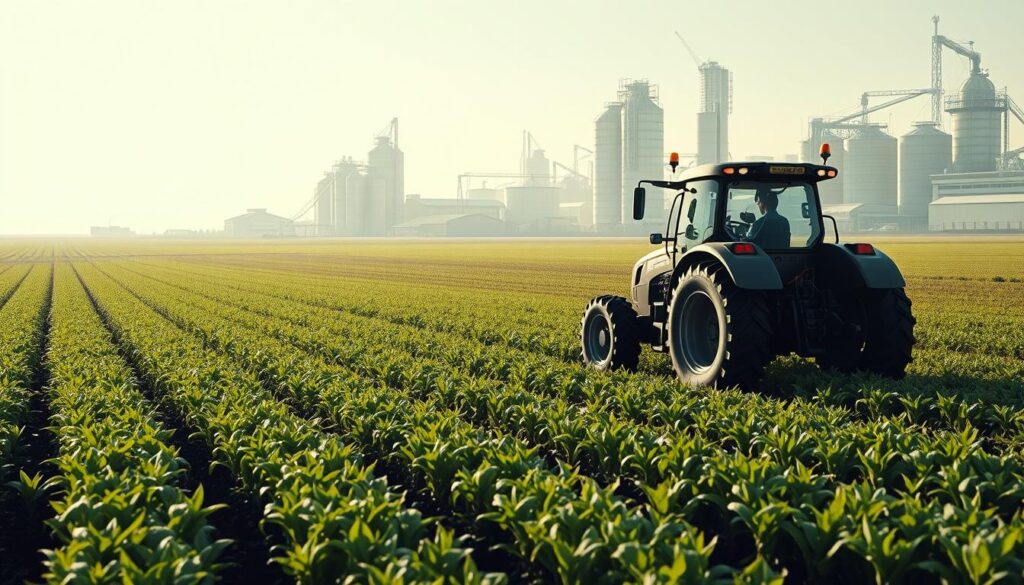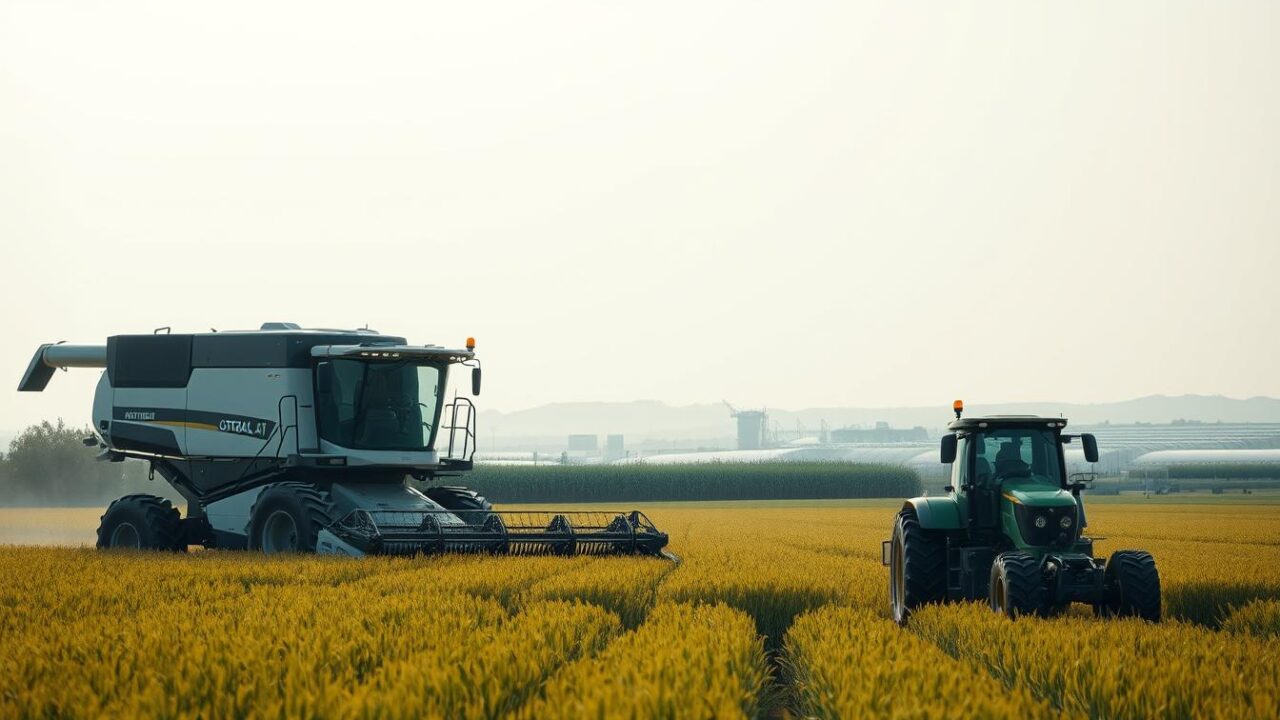Imagine producing enough food for 10 billion people using less land than we farm today. This staggering challenge collides with an equally remarkable solution: artificial intelligence could unlock £190 billion in agricultural value within a decade, according to industry analysts.
Traditional farming approaches struggle against climate volatility and resource scarcity. Yet forward-thinking growers now harness predictive algorithms that analyse soil health down to individual square metres. Microsoft’s AgriBot platform, for instance, helps farmers reduce water usage by 35% while maintaining yields.
The shift goes beyond gadgets in fields. Entire supply chains benefit from machine learning models that forecast crop prices with 92% accuracy, as demonstrated by ICRISAT’s recent trials in India. Such tools empower both smallholders and agribusinesses to make smarter decisions about planting cycles and market timing.
Key Takeaways
- Global food demands require 70% higher yields by 2050, necessitating smarter farming practices
- AI-driven systems currently achieve up to 20% better resource utilisation than conventional methods
- Enterprise-level solutions account for 62% of the technology’s economic impact in the sector
- Real-time data analysis helps mitigate climate risks through adaptive growing strategies
- Collaborations between tech firms and agricultural experts accelerate practical implementations
This transformation extends beyond mere efficiency gains. As one Californian vineyard manager remarked: “We’re not just growing grapes anymore – we’re cultivating data.” The fusion of biological wisdom with digital precision creates opportunities previously confined to laboratory settings, now thriving in real-world conditions.
Introduction to AI in Modern Farming

Faced with climate extremes and shrinking resources, those working the land are turning to digital solutions for answers. Over 600 million smallholder farmers – responsible for 80% of global food production – now confront unprecedented challenges. Limited land availability, workforce shortages, and deteriorating soil health demand innovative approaches that respect traditional knowledge while embracing technological progress.
Recent advancements in agriculture demonstrate how machine learning algorithms enhance decision-making for growers of all scales. A Kenyan coffee cooperative recently tripled yields using predictive analytics accessible through basic smartphones. As one agronomist noted:
“We’re not replacing generations of wisdom – we’re giving it superpowers.”
The democratisation of farming technology through cloud platforms allows remote communities to access real-time data analysis. This shift enables precise resource management without requiring advanced technical skills. Crucially, these tools adapt to local conditions rather than imposing one-size-fits-all solutions.
This evolution proves that innovation thrives when technology amplifies human expertise rather than displacing it. With 2 billion people relying on efficient food systems, such data-driven integrations become essential for global stability.
Understanding Agriculture Changes AI

The cultivation landscape is undergoing a silent revolution, powered by insights invisible to the human eye. Where growers once relied on generational wisdom, they now consult real-time analytics that assess soil moisture, nutrient levels, and microclimate variations simultaneously. This shift transforms how cultivation strategies evolve in response to environmental pressures.
Modern practices demand understanding intricate connections between rainfall patterns, seed genetics, and microbial activity. Machine learning models process these variables at speeds unmatchable by human analysis, identifying optimisation opportunities in irrigation schedules or fertiliser blends. As one Iowa-based agronomist observed:
“Our tractors now plant data points alongside seeds.”
Successful implementation requires rethinking traditional approaches. Producers adopting predictive systems report 18-22% reductions in resource waste while maintaining output quality. These tools don’t discard ancestral knowledge – they enhance it with hyperlocal weather predictions and disease outbreak forecasts.
The transformation extends beyond fields. Just as AI-driven marketing strategies personalise consumer interactions, agricultural algorithms tailor recommendations to individual plots. Continuous learning mechanisms allow systems to adapt recommendations based on shifting conditions, creating feedback loops that refine accuracy with each growing season.
Data-Driven Decision Making in Agriculture

Harvesting data has become as vital as harvesting crops in today’s cultivation strategies. Producers now access insights that transform every irrigation decision and fertiliser application into calculated actions rather than routine tasks.
Precision Irrigation and Soil Monitoring
Sophisticated sensor networks deliver real-time updates on moisture levels and nutrient distribution across fields. One California almond grower reported:
“Our system waters individual trees based on their exact needs, cutting waste while boosting kernel quality.”
These tools enabletargeted interventions, applying resources only where necessary rather than blanket treatments.
Predictive Analytics for Crop Yields
Advanced yield prediction models combine satellite imagery with hyperlocal weather patterns to forecast harvest volumes. Recent trials in Midwest maize fields achieved 94% accuracy in estimating outputs six weeks before maturation. This allows growers to:
- Adjust storage plans based on projected volumes
- Secure favourable market pricing through early negotiations
- Optimise labour allocation during harvest windows
The fusion of soil condition data with machine learning creates adaptive management systems. Rather than reacting to problems, farmers anticipate challenges – from nutrient deficiencies to pest outbreaks – before they impact yields.
Revolutionising Farm Management with Automation
The clatter of diesel engines now harmonises with the hum of microprocessors across rural landscapes. Field operations once requiring teams of workers now deploy self-guided machinery that operates with surgical precision. This shift addresses two critical pressures: chronic labour shortages and the demand for near-perfect consistency in food production.
Automated Machinery and Drones
Driverless tractors exemplify this transformation, executing planting patterns with centimetre-level accuracy across vast acreage. As one Nebraska grain producer noted:
“Our autonomous fleet works through the night, achieving what 15 seasonal workers couldn’t manage in daylight hours.”
Meanwhile, drones equipped with multispectral cameras map crop health indicators invisible to the human eye, enabling targeted interventions.
Robotics in Harvesting and Weeding
Delicate fruits like strawberries now meet robotic pickers that assess ripeness using 3D vision systems. These machines maintain 98.6% accuracy in selecting market-ready produce, reducing waste from mishandling. For weed control, camera-guided rovers zap invasive plants with micro-doses of herbicide, slashing chemical usage by up to 90% compared to blanket spraying.
Smart greenhouses showcase automation’s scalability, with AI adjusting climate settings every 30 seconds. Such systems cut energy costs by 40% while boosting yields through optimised growing conditions. The true power lies in integration – when drones, ground robots, and irrigation networks share data, they create feedback loops that refine operations season after season.
Enhancing Sustainability Through Precision Farming
Modern cultivation faces a critical balancing act: increasing output while preserving ecosystems. A Nebraska soybean producer summarises this challenge:
“We’re learning to work smarter with every acre, not harder.”
Optimising Soil Conditions and Fertiliser Use
Precision farming methodologies transform how growers manage scarce resources. Traditional practices often blanket fields with uniform treatments, wasting up to 90% of inputs. Advanced systems now map soil composition at 10cm intervals, enabling micro-dosing of nutrients where needed most.
Variable-rate technology exemplifies this shift. Farmers using GPS-guided equipment adjust fertiliser applications based on real-time crop requirements. One trial in Illinois maize fields achieved 22% higher yields using 15% less nitrogen – a win for both productivity metrics and groundwater protection.
Three innovations drive this progress:
- Sensor networks tracking soil moisture and pH fluctuations
- Machine learning models predicting nutrient uptake patterns
- Automated spreaders responding to field variability
These tools enable what experts call “prescription growing.” As highlighted in recent technology forecasts, such systems reduce chemical use while maintaining soil health. The precision approach proves sustainability and profitability aren’t opposing goals – they’re complementary outcomes of intelligent resource allocation.
Economic Benefits and Cost Savings in AgTech
The balance sheets of modern farming tell a new story – one where smart systems unlock profitability through precision. Recent analysis shows AgTech could deliver $250 billion in combined value, reshaping how producers approach resource allocation and operational spending.
Early adopters demonstrate striking results. One Washington apple grower reported:
“Our detection system spotted black rot infections three weeks before human scouts – saving 18% of this year’s crop.”
Such interventions prove crucial in boosting yields while controlling costs. Irrigation upgrades using smart sensors slash water use by 30% and energy bills by half. These savings compound across growing cycles, creating sustainable growth for operations of all sizes.
The financial potential extends beyond immediate returns. Mobile advisory services help smallholders increase production by 20-30% through tailored planting advice. Larger enterprises benefit from predictive models that optimise:
- Fertiliser application timing
- Harvest workforce planning
- Storage facility utilisation
While initial investments require careful budgeting, most farm operators recoup costs within three seasons. The scalability of these solutions means productivity gains accelerate over time – a critical advantage in competitive markets. As systems learn from each harvest, they refine recommendations to maximise efficiency and minimise waste.
This economic transformation positions AgTech not as an expense, but as a growth engine. By marrying operational savings with yield improvements, producers secure both short-term viability and long-term potential in an increasingly complex sector.
Overcoming Challenges in AI Adoption for Farming
Bridging the gap between technological potential and on-the-ground realities remains agriculture’s toughest puzzle. High implementation costs stall progress, particularly for smallholders managing razor-thin margins. As one Kenyan coffee grower noted:
“We need solutions that respect our budgets as much as our soil.”
- Financial hurdles: Initial investments often exceed £15,000 per hectare for sensor networks and automation tools
- Knowledge gaps: 78% of producers in developing nations lack access to digital literacy programmes
- Infrastructure deficits: Only 34% of rural areas globally have reliable connectivity for real-time data transmission
Cultural resistance compounds these issues. Many farming communities view smart tools as threats to generational wisdom rather than enhancements. Successful implementations, like a Nigerian millet cooperative’s yield-boosting initiative, demonstrate how phased approaches build trust. Producers first adopt moisture sensors before progressing to predictive analytics.
The industry’s path forward requires collaborative innovation. Tech developers must create intuitive interfaces – think tractor dashboards rather than coding platforms. Extension services should offer hands-on training using augmented reality simulations. When solutions align with practical needs rather than chasing complexity, adoption rates climb.
Emerging Trends and Future Innovations in AI Agriculture
The next phase of cultivation technology lies beyond visible fields – in code repositories and cloud servers where learning models evolve daily. Industry leaders predict 70% of farm management decisions will involve predictive tools within five years, reshaping how we approach food systems.
Integration of Generative and Analytical AI
Forward-thinking developers now combine pattern recognition with creative problem-solving. A Stanford University trial used generative technology to design crop rotation plans that boosted soil biodiversity by 18%. As one tech lead observed: “These systems don’t just analyse data – they imagine better futures.”
Hybrid approaches enable dynamic responses to unforeseen challenges. Machine learning tools process real-time weather shifts while generative models propose contingency strategies. This dual capability proves vital for maintaining yields during extreme climate events.
Advances in Sensor and Drone Technology
Next-generation field tools now detect plant stress signals at molecular levels. John Deere’s latest soil sensors measure 57 biomarkers, from nitrogen traces to beneficial fungi populations. Paired with autonomous drones mapping field topography, these innovations create living digital twins of entire operations.
The future promises even tighter integration. Researchers at MIT recently demonstrated nano-sensors that relay data through irrigation systems – a breakthrough that could slash monitoring costs by 40%. Such progress underscores how innovation thrives when hardware and software evolve in tandem.
Want to hire me as a Consultant? Head to Channel as a Service and book a meeting.

